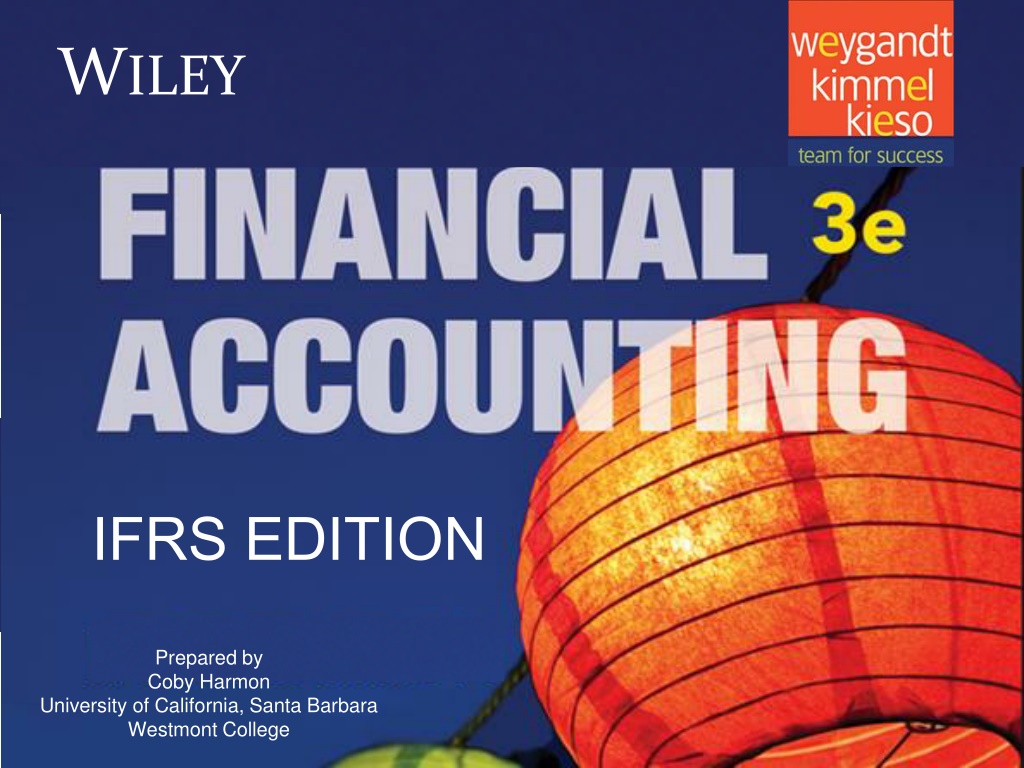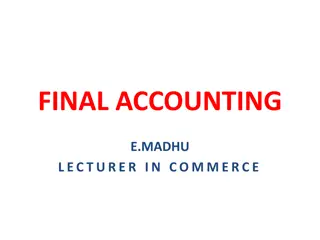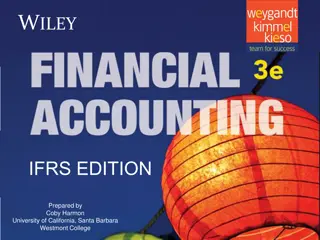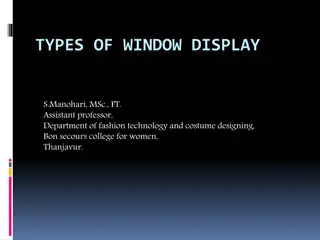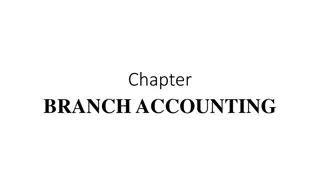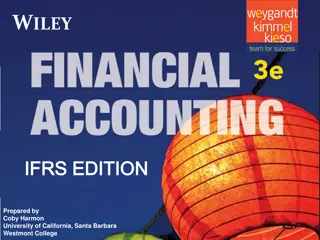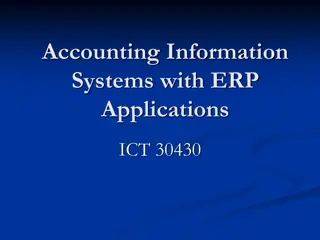Understanding Merchandising Operations in Financial Accounting
This content provides an in-depth look into accounting for merchandising operations, focusing on key concepts such as the differences between service and merchandising companies, recording purchases and sales, the accounting cycle for a merchandising company, income measurement, operating cycles, flow of costs, and recording sales of merchandise under a perpetual inventory system. It is a valuable resource for those looking to enhance their knowledge of financial accounting practices in the context of merchandising businesses.
- Merchandising Operations
- Financial Accounting
- Accounting Cycle
- Sales Revenue
- Perpetual Inventory System
Download Presentation

Please find below an Image/Link to download the presentation.
The content on the website is provided AS IS for your information and personal use only. It may not be sold, licensed, or shared on other websites without obtaining consent from the author. Download presentation by click this link. If you encounter any issues during the download, it is possible that the publisher has removed the file from their server.
E N D
Presentation Transcript
WILEY IFRS EDITION Prepared by Coby Harmon University of California, Santa Barbara Westmont College 5-1
PREVIEW OF CHAPTER 5 Financial Accounting IFRS 3rd Edition Weygandt Kimmel Kieso 5-2
CHAPTER 5 Accounting for Merchandising Operations LEARNING OBJECTIVES After studying this chapter, you should be able to: 1. Identify the differences between service and merchandising companies. 2. Explain the recording of purchases under a perpetual inventory system. 3. Explain the recording of sales revenues under a perpetual inventory system. 4. Explain the steps in the accounting cycle for a merchandising company. 5. Prepare an income statement for a merchandiser. 5-3
Merchandising Operations Learning Objective 1 Identify the differences between service and merchandising companies. Merchandising Companies Buy and Sell Goods Retailer Wholesaler Consumer The primary source of revenues is referred to as sales revenue or sales. LO 1 5-4
Merchandising Operations Income Measurement Not used in a Service business. Sales Revenue Less Illustration 5-1 Income measurement process for a merchandising company Equals Cost of Goods Sold Gross Profit Less Net Income (Loss) Equals Operating Expenses Cost of goods sold is the total cost of merchandise sold during the period. LO 1 5-5
Operating Cycles Illustration 5-2 The operating cycle of a merchandising company ordinarily is longer than that of a service company. Illustration 5-3 LO 1 5-6
Flow of Costs Illustration 5-4 Companies use either a perpetual inventory system or a periodic inventory system to account for inventory. LO 1 5-7
Recording Sales of Merchandise Learning Objective 3 Explain the recording of sales revenue under a perpetual inventory system. Made using cash or credit (on account). Sales revenue, like service revenue, is recorded when the performance obligation is satisfied. Performance obligation is satisfied when the goods are transferred from the seller to the buyer. Sales invoice should support each credit sale. Illustration 5-6 LO 3 5-8
Recording Sales of Merchandise Journal Entries to Record a Sale Cash or Accounts Receivable Sales Revenue XXX #1 Selling Price XXX #2 Cost of Goods Sold Inventory XXX Cost XXX LO 3 5-9
Recording Sales of Merchandise Illustration: PW Audio Supply records the sale of 3,800 on May 4 to Sauk Stereo on account (Illustration 5-6) as follows (assume the merchandise cost PW Audio Supply 2,400). May 4 Accounts Receivable 3,800 Sales Revenue 3,800 4 Cost of Goods Sold 2,400 Inventory 2,400 LO 3 5-10
ANATOMY OF A FRAUD Holly Harmon was a cashier at a national superstore for only a short while when she began stealing merchandise using three methods. Under the first method, her husband or friends took UPC labels from cheaper items and put them on more expensive items. Holly then scanned the goods at the register. Using the second method, Holly scanned an item at the register but then voided the sale and left the merchandise in the shopping cart. A third approach was to put goods into large plastic containers. She scanned the plastic containers but not the goods within them. One day, Holly did not call in sick or show up for work. In such instances, the company reviews past surveillance tapes to look for suspicious activity by employees. This enabled the store to observe the thefts and to identify the participants. Total take: $12,000 The Missing Controls Human resource controls. A background check would have revealed Holly s previous criminal record. She would not have been hired as a cashier. LO 3 5-11
ANATOMY OF A FRAUD Holly Harmon was a cashier at a national superstore for only a short while when she began stealing merchandise using three methods. Under the first method, her husband or friends took UPC labels from cheaper items and put them on more expensive items. Holly then scanned the goods at the register. Using the second method, Holly scanned an item at the register but then voided the sale and left the merchandise in the shopping cart. A third approach was to put goods into large plastic containers. She scanned the plastic containers but not the goods within them. One day, Holly did not call in sick or show up for work. In such instances, the company reviews past surveillance tapes to look for suspicious activity by employees. This enabled the store to observe the thefts and to identify the participants. Total take: $12,000 The Missing Controls Physical controls. Software can flag high numbers of voided transactions or a high number of sales of low-priced goods. Random comparisons of video records with cash register records can ensure that the goods reported as sold on the register are the same goods that are shown being purchased on the video recording. Employees should be aware that they are being monitored. LO 3 5-12
Sales Returns and Allowances Flip side of purchase returns and allowances. Contra-revenue account to Sales Revenue (debit). Sales not reduced (debited) because: Would obscure importance of sales returns and allowances as a percentage of sales. Could distort comparisons. LO 3 5-13
Sales Returns and Allowances Illustration: Prepare the entry PW Audio Supply would make to record the credit for returned goods that had a 300 selling price (assume a 140 cost). Assume the goods were not defective. May 8 Sales Returns and Allowances 300 Accounts Receivable 300 8 Inventory 140 Cost of Goods Sold 140 LO 3 5-14
Sales Returns and Allowances Illustration: Assume the returned goods were defective and had a scrap value of 50, PW Audio would make the following entries: May 8 Sales Returns and Allowances 300 Accounts Receivable 300 8 Inventory 50 Cost of Goods Sold 50 LO 3 5-15
Sales Returns and Allowances Question The cost of goods sold is determined and recorded each time a sale occurs in: a. periodic inventory system only. b. a perpetual inventory system only. c. both a periodic and perpetual inventory system. d. neither a periodic nor perpetual inventory system. LO 3 5-16
ACCOUNTING ACROSS THE ORGANIZATION Merchandiser s Accounting Causes Alarm Accounting for merchandising transactions is not always as easy as it might first appear. Recently, Tesco (GBR) announced that it had overstated profits by 263 million over a three-year period. The error related to how Tesco accounted for amounts received from suppliers for promotional activities of those companies products. When a retailer runs advertisements promoting a particular product, the producer of that product shares part of the advertising cost. Typically, the producer pays the merchandiser its share of the advertising cost as much as a year before the advertisement is run. The questions become, how should these amounts be reported by the merchandiser at the time it receives the funds, and when should these amounts affect income? The scandal surrounding this accounting treatment was serious enough that it caused the company s chairman to resign, and an outside auditing firm was brought in to investigate. One analyst commentated that we can never recall a period so damaging to the reputation of the company. Source: Jenny Anderson, Tesco Chairman to Step Down as Overstatement of Profit Grows, The New York Times Online (October 23, 2014). 5-17 LO 3
Sales Discount Offered to customers to promote prompt payment of the balance due. Contra-revenue account (debit) to Sales Revenue. LO 3 5-18
Sales Discount Illustration: Assume Sauk Stereo pays the balance due of 3,500 (gross invoice price of 3,800 less purchase returns and allowances of 300) on May 14, the last day of the discount period. Prepare the journal entry PW Audio Supply makes to record the receipt on May 14. May 14 Cash 3,430 Sales Discounts 70 * Accounts Receivable 3,500 * [( 3,800 300) X 2%] LO 3 5-19
DO IT! > On September 5, Zhu Company buys merchandise on account from Gao Company. The selling price of the goods is 15,000, and the cost to Gao Company was 8,000. On September 8, Zhu returns defective goods with a selling price of 2,000 and the fair value of 300. Record the transactions on the books of Gao Company. Sept. 5 Accounts Receivable Sales Revenue 15,000 15,000 Sept. 5 Cost of Goods Sold Inventory 8,000 8,000 LO 3 5-20
DO IT! > On September 5, Zhu Company buys merchandise on account from Gao Company. The selling price of the goods is 15,000, and the cost to Gao Company was 8,000. On September 8, Zhu returns defective goods with a selling price of 2,000 and the fair value of 300. Record the transactions on the books of Gao Company. Sept. 8 Sales Returns and Allowances Accounts Receivable 2,000 2,000 Sept. 8 Inventory Cost of Goods Sold 300 300 LO 3 5-21
Recording Sales of Merchandise Learning Objective 4 Explain the steps in the accounting cycle for a merchandising company. Adjusting Entries Generally the same as a service company. One additional adjustment to make the records agree with the actual inventory on hand. Involves adjusting Inventory and Cost of Goods Sold. LO 4 5-22
Adjusting Entries Illustration: Suppose that PW Audio Supply has an unadjusted balance of 40,500 in Merchandise Inventory. Through a physical count, PW Audio determines that its actual merchandise inventory at year-end is 40,000. The company would make an adjusting entry as follows. Cost of Goods Sold 500 Inventory 500 LO 4 5-23
